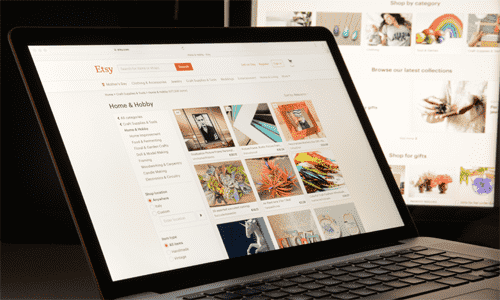Despite having millions of active sellers between them, sites like Etsy, eBay and Amazon have qualities that some sellers just can't reconcile. Often these budding eCommerce moguls will start to feel like it's time to spread their wings and set up a business website of their very own. But whether this is the right idea or time can be difficult to know.
Firstly, let's think about the pros and cons of selling on a pre-prepared marketplace or your website:
Selling on a marketplace

Pros
- Ready to rock: big-name marketplaces are popular for a reason and that being that they take next to no time to set-up! There is no need for web designers, programmers, or any technical stuff, simply upload your products and start selling.
- Guaranteed customer trust: when you sell on a site like eBay or Etsy, you can sell under the trustworthy wing of that company. Your store benefits from the branding and development of that marketplace and means customers inherently trust you too.
- Wider customer pool: consumers are always trawling through marketplaces, so chances are they will scroll onto yours! These marketplaces get high volumes of visitors every single day, so your store is very likely to catch a few buyers in the process.
- Help is always on hand: you're usually only a phone call or message away from their dedicated help team offering expert advice. As these sites promote such a wide community of sellers, you can often use community boards and help threads so fixing issues or bugs is easy!
Cons
- Limited customisation: when you open a store with Etsy, eBay or Amazon you're pretty limited in terms of your storefront and how it looks to visiting customers. This may not be a drawback when you're starting out, but if you're gaining traction, this can detract from your customer's experience of your brand.
- Lack of control: as comes with selling on a larger marketplace, you are subject to the whims and passing fancies of the website's changes and design alterations. Of course, convenience comes with a cost so putting up with policy changes is a fact on these marketplaces.
- High levels of competition: although these sites can draw customers to your store, you will be competing with many similar stores. As does happen in the ruthless world of entrepreneurship, sellers are known to steal others' ideas to get ahead, so selling alongside these stores can create heated competition.
- It does cost a penny: These sites may seem like they are just offering a marketplace where sellers can sell unhindered, but they do charge you to sell! It may not seem like much, varying from 15p on Etsy to 35p on eBay, plus a cut of the selling fees. If you sell sporadically and are starting out, this can soon add up!
Selling on your own website

Pros
- Better control: when you have your own website, of course, you can design and run it all! You can control the look, the experience and the marketing of it all and chop and change it whenever you feel like it. Your marketing efforts will have more effect on a stand-alone business website, as you can add banners, pop-ups - the whole shebang!
- Customers will take you seriously: if your website is well-designed and thought out it presents a more professional business to customers. But it's important that it looks good and runs smoothly. Slap-dash or outdated websites tend to scare customers away. Creating a website is a great way to show that you are an established brand and ooze professionalism.
- Fewer distractions: we all know how unreadable the web has become these days, with cookie approval requests, pop-up ads, and email sign-up forms. Selling on marketplaces can mean customers are bombarded with banners and sidebars and all sorts, but this can be avoided on your own website. You can create a space dedicated to your business and products, reducing the chance of customers being drawn off to another page.
Cons
- Takes planning: if you aren't familiar with web design, setting up your own business website can be a little tricky. Many helpers like Shopify, WooCommerce and BigCommerce take you step-by-step through the set-up process, but to avoid usability pitfalls and create a truly unique design can take time and learning. Just a few of the things you'll need to plan is your SEO plan, your shopping cart provider and your payment provider, to name a few.
- Needs more marketing: when you start a business website, you won't automatically be featured on any search results or popular stores pages. This will only come through marketing, and it can take time. Marketing can come in lots of forms be it a blog, a social media presence, emails, flyers, paid ads; the list goes on. Any efforts you make aren't guaranteed to get you seen, but they can't hurt!
- Ever-present competition: now, competition isn't only fierce on marketplaces. There are millions of stores with lovely websites just waiting to nab your customers away on the world-wide-web. Setting up a business website of your own means you have the competition of sellers on marketplaces, but you also have to go head-to-head with other stand-alone websites selling similar products!
Have you solidified your decision to start a website or are you even more confused on the matter? Well, you don't have to choose one or the other just yet. Many sellers choose to use both in the interim while setting up their own website. So either way, if you're looking to make a move here are some tips to ensure the process goes smoothly and you come out the other end with a fantastic website!
Tips for marking the move to your own website

Consider expenses
eCommerce website builders mainly all have monthly subscription fees. Before deciding on which one you'll use for your website, make sure you write down all of your expenses and see if you can actually afford to keep it up.
Do your sales fluctuate massively? Are you approaching a season where your products will be less popular? Think about factors that could affect your monthly revenue and if you'll be able to cover the cost of your website host during quiet periods.
Prioritise usability
Now, prioritising usability doesn't mean you can get away with a workable site that looks like it was designed in 2002. When creating a website from scratch or via a template, you need to make sure that customers can logically navigate it. You wouldn't want customers thinking your products aren't worth the trek it took to find the checkout portal, would you?
The rule of thumb is the fewer clicks it takes to get the customer to the checkout the better. This way, you can take advantage of impulse buyers and create an unhindered route straight to payment!
Maintain your branding
Of course, branding is also essential. One of the biggest pros for moving from a marketplace to your own website is free reign over design, so make sure you think colour, style and flair! Having a well-branded website shows that your brand is well-rounded, established and professional.
At Interparcel, we know how key branding can be in creating an excellent experience for customers. That's why we created our Branded Tracking feature so that businesses can provide their customers with a seamless branded experience even when tracking their order en route! This feature allows you to add a logo, colour scheme and other features so that your brand is our brand.
Use reliable shipping services

Not having reliable shipping services will automatically put customers off re-visiting your website! Thankfully, when you connect your website with Interparcel we can find you the cheapest parcel delivery rates from the globe's best couriers. By connecting your online store to our Shipping Manager, you can benefit from our new email notifications, as well as branded tracking and prepay features.
Integrate your store with us for free today to start applying these handy benefits to your new website:
- Free account set up
- Parcel Presets to shortcut package detail input
- Access to a range of eCommerce integrations through our Shipping Manager
- Full use of our 'Send Again' and 'Return Parcel' actions to streamline sending
- Branded Tracking for a seamless company experience
- Unlimited no-cost label printing options
We've partnered with all the biggest and best eCommerce platforms such as BigCommerce, WooCommerce, Shopify, Magento, and more. Plus, all of these platforms can import/export your Etsy, eBay or Amazon listings and bring them straight over to your website.
No matter which eCommerce platform you choose for your website, make sure to choose Interparcel for your shipping. We will gather all of your order information into one neat and easy-to-use area. We will provide you with address labels, discounted shipping services, and even email notifications to keep shipping simple!
We know that customers love choice, so by using our Shipping Manager to integrate your eCommerce store, you can offer them special services like Same Day, Pre 9 am, and Next Day delivery to name a few!
Think about your wording
When setting up your product pages, or any page for that matter, you'll need to think about what language will best draw browsers to buy. Have a little look at what wording similar retailers have used on their own websites to see what keywords are working for them.
This also goes for FAQ and About pages, as these are most likely going to be popular pages with visiting customers looking to find out more. Try to use clear, concise language so that you can get your point across asap without boring the customer away!
Get your policies down

Returns policies are very important when setting up your website. 95% of online consumers have stated they will repeatedly purchase from a seller if they provide a solid business returns policy or exchange experience. So having a clear policy is essential.
Include the basics, like:
- What items can be returned (and what can't)
- How long after purchase items can be returned
- What condition the item must be in to be returned
- What the procedure is to return an item
Applying this information to your FAQs page would be sufficient to give customers a good idea of your return policy. Plus, make sure you also add how long your shipping usually takes, any customs costs and other info the customer may need to know.
To make the return parcel process even easier, at Interparcel, we have a 'Return Parcel' action. This simply switches the original delivery addresses around and enables businesses to generate returns labels for their customers. Speeding up and simplifying the returns process.
Learning how to make a business website your own can be a liberating step in your entrepreneurial journey, but there's no rush to leave your marketplace home! Selling on multiple platforms is often the better choice for some sprouting sellers. Why not test the waters and see what works for your business - start a business website today!










 Facebook
Facebook Twitter
Twitter Instagram
Instagram Linked In
Linked In YouTube
YouTube